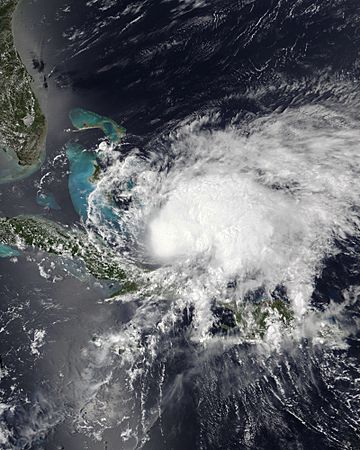Hurricane Isaias facts for kids
| Category 1 hurricane (SSHWS/NWS) | |

Hurricane Isaias near peak intensity on July 31
|
|
| Formed | July 30, 2020 |
|---|---|
| Dissipated | August 5, 2020 |
| Highest winds | 1-minute sustained: 80 mph (130 km/h) |
| Lowest pressure | 987 mbar (hPa); 29.15 inHg |
| Damage | $4.7 billion (2020 USD) |
| Areas affected | Windward Islands, Bahamas, East Coast of United States, Eastern Canada |
| Part of the 2020 Atlantic hurricane season | |
Hurricane Isaias was a powerful Atlantic tropical storm that happened in July and August of 2020. It traveled across the Leeward Islands, Hispaniola, and Bahamas. Later, Isaias moved towards the East Coast of the United States, from Florida all the way up to Maine.
How Isaias Formed
Isaias started as a weather system called Potential Tropical Cyclone Nine on July 28. This means it had the chance to become a tropical storm. It then grew stronger and was officially named Tropical Storm Isaias on July 30.
Isaias's Journey and Impact
As Isaias moved, warnings for hurricanes or tropical storms were put in place. These warnings stretched from the Windward Islands to the East Coast of the United States. The storm officially made landfall in North Carolina on August 4 at 03:10 UTC. After hitting North Carolina, it moved quickly up the East Coast. Isaias finally weakened and disappeared on August 5.
Isaias brought strong winds and heavy rains to many places. It caused damage to buildings and trees. Some areas also experienced tornadoes that formed because of the storm.
Images for kids
-
Pitahaya River in Luquillo, Puerto Rico, on August 1 after being flooded by Isaias's rains.
-
Hurricane Isaias making landfall near Ocean Isle Beach, North Carolina as seen on weather radar.
-
Mobile homes damaged near Windsor, North Carolina due to an EF3 tornado.
-
Tree downed by Isaias in Wilmington, North Carolina.
-
Damage from an EF2 tornado spawned by Isaias in Doylestown, Pennsylvania.
See also
 In Spanish: Huracán Isaías para niños
In Spanish: Huracán Isaías para niños







